 W
WList of annelid families describes the taxa relationships in the phylum Annelida, which contains more than 17,000 extant species including ragworms, earthworms, and leeches.
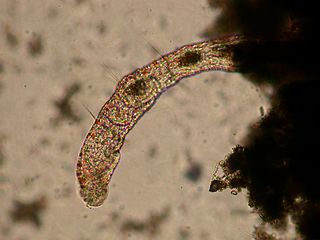 W
WThe Aeolosomatidae is a family of very small, aquatic annelid worms, the affinities of which are uncertain other than that they are related to Pomatodrilus. About 30 species have been described in three genera. These worms are known as suction-feeding worms and occupy freshwater habitats.
 W
WThe Chaetopteridae are a family of marine filter-feeding polychaete worms that live in vertical or U-shaped tubes in tunnels buried in the sedimentary or hard substrate of marine environments. The worms are highly adapted to the hard tube they secrete. Inside the tube the animal is segmented and regionally specialized, with highly modified appendages on different segments for cutting the tunnel, feeding, or creating suction for the flow of water through the tube home. The modified segments for feeding are on the 12th segment from the head for members of this family.
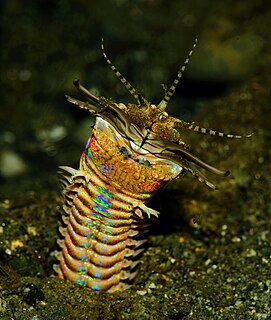 W
WEunicidae is a family of marine polychaetes. The family comprises marine annelids distributed in diverse benthic habitats across Oceania, Europe, South America, North America, Asia and Africa. The Eunicid anatomy typically consists of a pair of appendages near the mouth (mandibles) and complex sets of muscular structures on the head (maxillae) in an eversible pharynx. One of the most conspicuous of the eunicids is the giant, dark-purple, iridescent "Bobbit worm", a bristle worm found at low tide under boulders on southern Australian shores. Its robust, muscular body can be as long as 2 m. Eunicidae jaws are known from as far back as Ordovician sediments. Cultural tradition surrounds Palolo worm reproductive cycles in the South Pacific Islands. Eunicidae are economically valuable as bait in both recreational and commercial fishing.
 W
WThe Euphrosinidae are a family of polychaete worms. The name is from Greek Euphrosyne, meaning merriment; she was one of the three Graces.
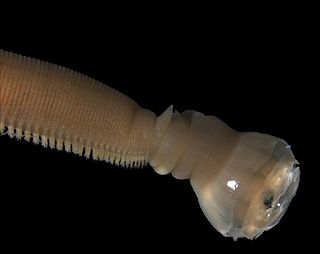 W
WGlyceridae is a family of polychaete worms. They are commonly referred to as beak-thrower worms or bloodworms. They are bright red, segmented, aquatic worms. The proboscis worm Glycera is sometimes called bloodworm. The Glyceridae are ferocious epi- and infaunal polychaetes that prey upon small invertebrates. They are errant burrowers that build galleries of interconnected tubes to aid in catching their prey.
 W
WGolfingiidae is a family of peanut worms.
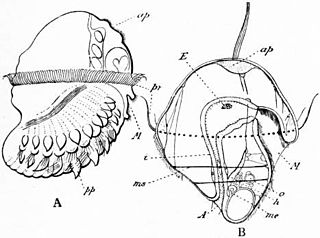 W
WLopadorrhynchidae is a family of polychaete worms.
 W
WNephtyidae is a taxonomic family of polychaete worms. They are commonly referred to as catworms.
 W
WNereididae are a family of polychaete worms. It contains about 500 – mostly marine – species grouped into 42 genera. They may be commonly called ragworms or clam worms.
 W
WPhyllodocidae is a family of polychaete worms. Worms in this family live on the seabed and may burrow under the sediment.
 W
WPilargidae is a family of polychaetes. These marine worms are cylindrical, somewhat flattened, and can be ribbon-like. They can be found free-living on sediment, or shallowly in sediment. Some species within the genera Hermundura and Litocorsa are known to burrow, having reduced heads and parapodia. Two species are known to be commensal with other polychaetes. Pilargis berkeleyae will live in the tubes of Chaetopteridae, and Ancistrosyllis commensalis will live in Capitellidae burrows. Pilargid worms are almost all exclusively predators, classified as carnivore omnivores. They are similar in appearance to Hesionidae, with a peristomium often with two pairs of tentacular cirri, reduced or absent notopodia, and a lack of pharyngeal jaws. The first few segments bearing setigers are also somewhat fused. They can have 0 to 3 antennae, and palps. These polychaetes are rarely the most abundant polychaete.
 W
WPoecilochaetidae is a family of marine worms within the Polychaeta. It is a monotypic family containing the single genus Poecilochaetus. Members of this family are benthic worms that burrow into soft sediments.
 W
WPolynoidae is a family of marine Polychaete worms known as "scale worms" due to the scale-like elytra on the dorsal surface. Almost 900 species are currently recognised belonging to 9 subfamilies and 167 genera. They are active hunters, but generally dwell in protected environments such as under stones. The group is widely distributed from shallow intertidal waters to hadal trenches. They are the most diverse group of polychaetes in terms of genus number and second most diverse in terms of species number which is almost 8% of all segmented worm species.
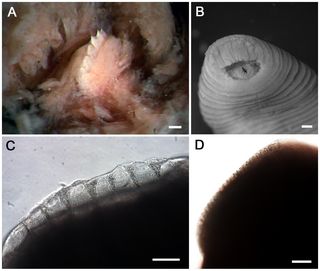 W
WPraobdellidae is a family of hematophagous leeches which live on the mucous membranes of mammals. These are internal parasites that enter the body through natural orifices, and cause hirudiniases.
 W
WSabellidae, or feather duster worms, are a family of marine polychaete tube worms characterized by protruding feathery branchiae. Sabellids build tubes out of a tough, parchment-like exudate, strengthened with sand and bits of shell. Unlike the other sabellids, the genus Glomerula secretes a tube of calcium carbonate instead. Sabellidae can be found in subtidal habitats around the world. Their oldest fossils are known from the Early Jurassic.
 W
WThe Serpulidae are a family of sessile, tube-building annelid worms in the class Polychaeta. The members of this family differ from other sabellid tube worms in that they have a specialized operculum that blocks the entrance of their tubes when they withdraw into the tubes. In addition, serpulids secrete tubes of calcium carbonate. Serpulids are the most important biomineralizers among annelids. About 300 species in the family Serpulidae are known, all but one of which live in saline waters. The earliest serpulids are known from the Permian.
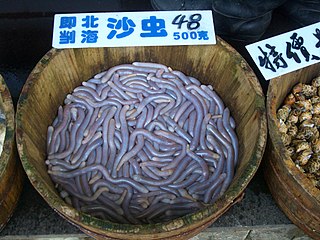 W
WSipunculidae is a family of peanut worms.
 W
WSpionidae is a family of marine worms within the Polychaeta. Spionids are selective deposit feeders that use their two grooved palps to locate prey. However, some spionids are capable of interface feeding, i.e. switching between deposit and suspension feeding.
 W
WSyllidae is a family of small to medium-sized polychaete worms. Syllids are distinguished from other polychaetes by the presence of a muscular region of the anterior digestive tract known as the proventricle.
 W
WUrechidae is a family of spoonworms in the subclass Echiura. The only genus in the family is Urechis, which has four species.